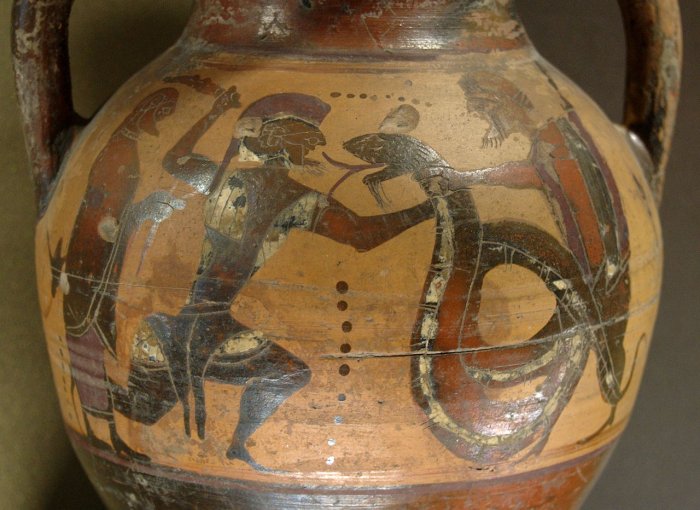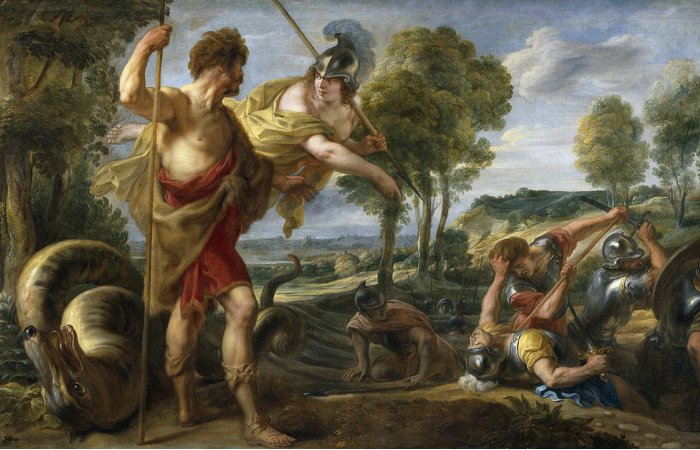A. Sutherland – AncientPages.com – This legend is devoted to Cadmus, who in Greek mythology was the legendary Phoenician hero and founder of Boeotian Thebe, husband of Harmony, and one of the five sons of King Agenor (“heroic, manly”) of Tyre.

Cadmus fighting the dragon depicted on an ancient vase. Credit: Louvre – Public Domain
The King sent his sons into the world for his sister Europa, whom Zeus kidnapped, and the brothers’ task was challenging since their father ordered them to return when they found their sister.
Cadmus was, alongside Perseus and Bellerophon, the greatest hero and slayer of monsters before the days of the mighty Heracles.
Foundation Of the City of Cadmea (Thebes) And Killing Of A Dragon
Unsuccessfully searching for Europa, the brothers settled in Greece. Remembering his father’s injunction not to return without his sister, Cadmus decided to come to rest outside his homeland. At first, however, he wanted to ask the oracle where he was to live.
She gave him some advice: follow the cow, which has a birthmark in the shape of a moon, and in this special place, you have to establish a new city and stay there. It took time to find a magical cow, but at last, Cadmus spotted the animal. King Pelagon of Fokis gave him the cow, and Cadmus unleashed it.
The cow wandered for quite a while before it got tired and lay down. Cadmus knew that it was this particular place destined for his new city. He built an altar where sacrifices could be made to the gods. He intended to sacrifice the cow in return for the guidance of the gods and sent some of his men to fetch water to wash themselves with. The men found a clear water spring and began filling the pots they had brought.
But soon, a snake-like dragon appeared. He guarded the spring belonging to the god of war, Ares, and did not let any man approach the water.
Quickly, the creature killed almost all the men. Cadmus had to kill a dragon to have access to a source of fresh water. Then, Athena instructed him to sow all the teeth of the beast, and so the hero did. An army of warriors (“Sown Men”- Spartoi) grew from the ground and fought against each other until the last five only remained, helping Cadmus build his new city of Thebes.
And yet, Cadmus suffered guilt for killing the Castalian serpent of the god of war. As punishment, he was forced to serve Ares for eight years. Then, he was awarded the lovely Harmonia.

Cadmus and Minerva (Minerva being the Roman version of Athena) – Jacob Jordaens (1593–1678). Credit: Public Domain
After his eight-year-long punishment, the goddess Athena secured him the land of Boeotia. With the help of his “Sown Men,” he built the Theban acropolis, named ‘The Cadmea’ in his honor, and married Harmonia, the daughter of Aphrodite and Ares. According to a version, Athena had given her to him when he visited Samothrace, the home of the Sanctuary of the Great Gods, the site of important Hellenic and pre-Hellenic religious ceremonies.
Cadmus’ wedding with Harmonia was the first mortal wedding ever attended by the Olympians. Twelve golden thrones were set up for them in Cadmus’s house, which stood on the present Theban marketplace’s site; they all brought gifts.
Aphrodite presented Harmonia with the famous golden necklace made by Hephaestus. Originally, it had been Zeus’s love gift to Cadmus’s sister Europe, conferring overwhelming beauty on its wearer.
They finally retired to Illyria and lived happily, but when the Illyrians later angered the gods and were punished, Cadmus and Harmonia were saved, being changed into black serpents and sent by Zeus to the Islands of the Blessed (Elysian Fields).
The later nobles of Thebes are said to have descended from these surviving legendary men. The Greeks attributed the foundation of Thebes to Cadmus, and he has a respectable place in Greek mythology. The Phoenician King from Tyre was famous for teaching the Phoenician alphabet and building the Acropolis, an intellectual, spiritual, and cultural center named the Cadmeia in his honor.
According to the Greek version of his story, Cadmus is the ancestor of Illyrians and Theban royalty. He was a good ruler for his people, making Thebes a prosperous city
Written by – A. Sutherland – AncientPages.com Senior Staff Writer
Updated on January 2, 2024
Copyright © AncientPages.com All rights reserved. This material may not be published, broadcast, rewritten or redistributed in whole or part without thexpress written permission of AncientPages.com
Expand for references
References:
Leeming, D. The Oxford Companion to World Mythology
Cotterell, A. A Dictionary of World Mythology
raves, R. The Greek Myths





